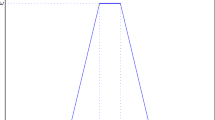Abstract
In this chapter, we discuss the essential difference between fuzzy risk analysis and probability risk analysis. Then, we use the method of the information distribution to improve probability estimate in the probability risk analysis, and we develop the method to calculate the fuzzy risk with respect to the possibility-probability. The benefit of fuzzy risk assessment is that the new result saves more information for risk management.
Project Supported by National Natural Science Foundation of China, No.49971001
Access this chapter
Tax calculation will be finalised at checkout
Purchases are for personal use only
Preview
Unable to display preview. Download preview PDF.
Similar content being viewed by others
References
C.B. Brown, A fuzzy safety measure, J. Engineering Mechanics 105 (1979), 855–872.
Chongfu Huang and Da Ruan, Information diffusion principle and application in fuzzy neuron, Fuzzy Logic Foundations and Industrial Applications (edited by Da Ruan, Kluwer Academic Publishers, Massachusetts, 1996 ), 165–189.
D.P. Clement, Fuzzy Ratings for Computer Security Evaluation, Ph.D. Dissertation, University of California at Berkeley (1977).
M. Delgado, J.L. Verdegay and M.A. Vila, A model for linguistic partial information in decision-making problems, International Journal of Intelligent Systems, 9 (1994), 365–378.
W.M. Dong and et al., Fuzzy computation in risk and decision analysis, Civil Engineering Systems 2 (1986), 201–208.
A.O. Esogbue and et al., On the application of fuzzy sets theory to the optimal flood control problem arising in water resources systems, Fuzzy Sets and Systems 48 (1992), 155–172.
F.C. Hadipriono, A rule-based fuzzy logic deduction technique for damage assessment of protective structures, Fuzzy Sets and Systems 44 (1991), 459–468.
L.J. Hoffman, E.H. Michelmen and D.P. Clements, SEURAT—Security evaluation and analysis using fuzzy metrics, Proc. of the 1978 National Computer Conference (AFIPS Press, Montvale, New Jersey, 1978 ) 47, 531–540.
Huang Chongfu, Principle of information diffusion, Fuzzy Sets and Systems, 91 (1) (1997), 69–90.
Huang Chongfu, Concepts and methods of fuzzy risk analysis, Proceedings of the First China-Japan Conference on Risk Assessment and Manage-ment,Beijing, China, November, 1998, 12–23.
Huang Chongfu and Shi Peijun, Fuzzy risk and calculation, Proceedings of 18th International Conference of the North American Fuzzy Information Processing Society, (1999), 90–94
M. Jablonowski, Fuzzy risk analysis: using AI system, AI Expert, 9 (12) (1994), 34–37.
Huang Chongfu, Fuzzy risk assessment of urban natural hazards, Fuzzy Sets and Systems, 83 (1996), 271–282
E.E. Kerre, Fuzzy Sets and Approximate Reasoning (Xian Jiaotong University Press, Xian, China, 1999 ).
R. V. Kolluru, S. M. Bartell, R.M., Pitblado, and R. S. Stricoff, Risk Assessment and Management Handbook for Environmental, Health, and Safety Professionals ( McGraw-Hill, New York, 1996 )
A.V. Machias and G.D. Skikos, Fuzzy risk index of wind sites, IEEE Trans. Energy Conversion, 7 (4) (1992), 638–643.
A.P. Sage and E.B. White,Methodologies for risk and hazard assessment: a survey and status report, IEEE Trans. Systems, Man, and Cybernetics, SMC-10(8)(1980), 425–446.
K.J. Schmucker, Fuzzy Sets, Natural Language Computations, and Risk Analysis (Computer Science Press, Rockvill, Maryland, 1984 )
L.A. Zadeh, Fuzzy sets, Information and Control, 8 (3) (1965), 338–353.
L.A. Zadeh, Toward a theory of fuzzy information granulation and its centrality in human reasoning and fuzzy logic, Fuzzy Sets and Systems 90 (2) (1971), 111–127.
L.A. Zadeh, Toward a restructuring of the foundations of fuzzy logic (FL), Proceedings of FUZZ-IEEE’98, Anchorage, USA, May, 1998, 1676–1677.
Author information
Authors and Affiliations
Editor information
Editors and Affiliations
Rights and permissions
Copyright information
© 2001 Physica-Verlag Heidelberg
About this chapter
Cite this chapter
Huang, C. (2001). Fuzzy Risk Analysis Vs. Probability Risk Analysis. In: Ruan, D., Kacprzyk, J., Fedrizzi, M. (eds) Soft Computing for Risk Evaluation and Management. Studies in Fuzziness and Soft Computing, vol 76. Physica, Heidelberg. https://doi.org/10.1007/978-3-7908-1814-7_3
Download citation
DOI: https://doi.org/10.1007/978-3-7908-1814-7_3
Publisher Name: Physica, Heidelberg
Print ISBN: 978-3-662-00348-0
Online ISBN: 978-3-7908-1814-7
eBook Packages: Springer Book Archive




